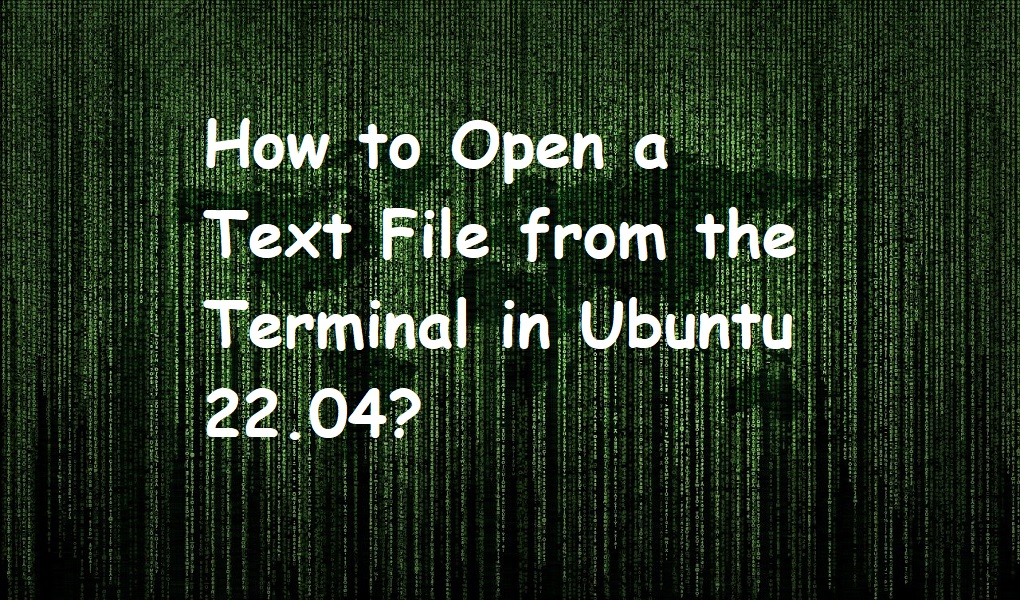If you’re looking to adopt Ubuntu as your daily driver, knowing how to open a text file from the terminal can make you feel right at home. Whether you’re a coding whiz, a sysadmin pro, or just curious about Ubuntu, we’ve got your back. Today, we’re not looking into the installation of any tool, but we’ll look at the readily available tools/commands to make life easier for you.
So, buckle up and let’s dive into all the commands you can use to open a text file straight from the terminal. As we go, we’ll discuss the details of each command in detail.
Using the “cat” command
You can use the “cat” command to display the contents, concatenate, and create text files. You can open a text file like:
$cat [file_name]
So for example, if need to open your “report.txt” file, you can do so as following:
$cat report.txt

Here you can see that running the command will display the contents of the file directly using the terminal rather than opening in a text editor.
Using the “less” command
Unlike the “cat” command, when you run the “less” command will display the contents of a file one page at a time. The syntax for opening a file using the “less” command is pretty similar to the “cat” command.
$less [file_name]
Let’s say that you want to open the same file, this is how you’ll do it:
$less report.txt

You can navigate between the pages of the document using the up and down arrow keys.
Using the “nl” command
You can open up a text file with the output having numbered lines using the “nl” command. Similar to the last two commands, you can open up a text file using the “nl” command as follows:
$nl report.txt

With this output, you’ll see the same file used in the last commands but with the output having numbered lines.
Using the “more” command
The “more” command lets you seamlessly scroll through a text file, providing a straightforward way to read without overwhelming your screen. Simply type “more” followed by the file name, hit Enter, and voila – you’re on a smooth-scrolling journey through the text.
$more report.txt

It’s the go-to for a quick peek into file contents without any unnecessary frills. Stay tuned as we explore more Terminal hacks to master the art of file handling in Ubuntu!
Using the “head” command
When it comes to getting a rapid overview of a text file in the Ubuntu Terminal, the “head” command is your trusty guide. Just type “head” followed by the file name, and you’ll get an instant peek at the initial lines of the file. Let’s say you want to check out the beginning of a file named “example.txt”; you’d enter:
$head example.txt

This command proves especially handy when you’re dealing with large files or just need a quick glance at the file’s introduction. Stay tuned as we uncover more Terminal tricks to enhance your file-handling prowess in Ubuntu!
Using the “tail” command
When it comes to exploring the tail end of a text file in the Ubuntu Terminal, the “tail” command takes center stage. Unlike its counterpart, “head,” which gives you a glimpse of the file’s beginning, “tail” lets you peek at the last few lines. Just type “tail” followed by the file name, and you’ll get an immediate snapshot of the file’s conclusion. For instance, if you’re curious about the final lines of a log file named “logfile.txt,” the command would be “tail logfile.txt.” This command proves invaluable for tracking real-time updates, monitoring logs, or simply checking out what’s happened most recently.
$tail logfile.txt

Conclusion
So, mastering the art of opening text files in the Ubuntu Terminal is a fundamental skill for both coding enthusiasts and system administrators alike. Whether you opt for the simplicity of commands like “cat,” “more,” or “less,” or dive into the robust capabilities of terminal-based text editors such as “nano” and “emacs,” the versatility of Ubuntu’s command-line interface empowers users to efficiently navigate and manipulate text files.
As you continue your journey into the world of Linux, honing these skills not only enhances your productivity but also deepens your understanding of the intricate workings of the operating system. So, whether you’re crafting code, managing configurations, or exploring logs, the Ubuntu Terminal provides a dynamic and powerful environment for seamlessly interacting with your text files. Happy coding!




